As debates continue over whether chatbots should have a role in the classroom, more teens are turning to ChatGPT to help with schoolwork.
Pew Research Center conducted this analysis to understand American teens’ use and understanding of ChatGPT in a school setting.
We surveyed 1,391 U.S. teens from Sept. 18 to Oct. 10, 2024, through Ipsos. Ipsos recruited the teens via their parents, who were part of its KnowledgePanel. The KnowledgePanel is a probability-based web panel recruited primarily through national, random sampling of residential addresses. The survey was weighted to be representative of U.S. teens ages 13 to 17 who live with their parents by age, gender, race and ethnicity, household income, and other categories.
Here are the questions used for this analysis, along with responses, and its methodology.
This research was reviewed and approved by an external institutional review board (IRB), Advarra, an independent committee of experts specializing in helping to protect the rights of research participants.
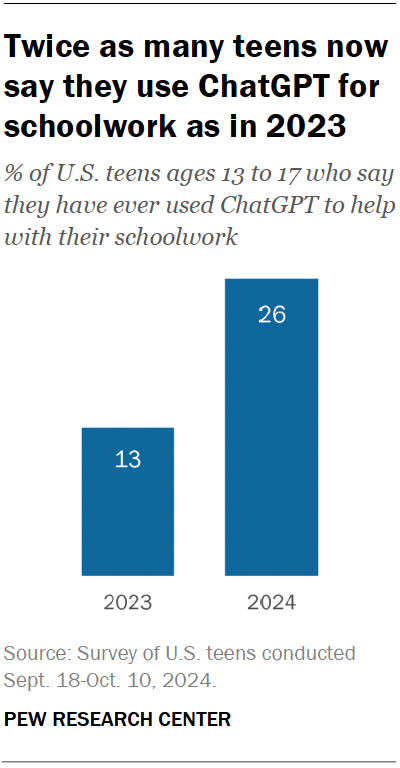
The share of teens who say they use ChatGPT for their schoolwork has risen to 26%, according to a Pew Research Center survey of U.S. teens ages 13 to 17. That’s up from 13% in 2023.
Still, most teens (73%) have not used the chatbot in this way.
Teens’ use of ChatGPT for schoolwork increased across demographic groups. But certain groups stand out for using the chatbot in this way:
By race and ethnicity
Black and Hispanic teens (31% each) are more likely than White teens (22%) to say they have used ChatGPT for their schoolwork. But this wasn’t the case as recently as last year.
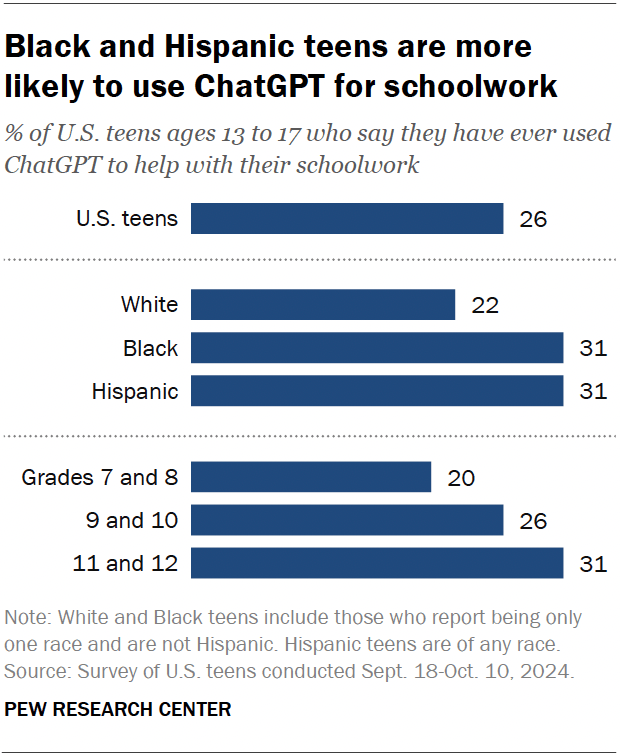
In 2023, similar shares of White (11%), Black (13%) and Hispanic teens (11%) said they used the chatbot for schoolwork. (There were not enough Asian teens in the sample to be broken out into a separate analysis.)
By grade level
Teens in 11th and 12th grade (31%) are more likely than seventh and eighth graders (20%) to say they use ChatGPT for their schoolwork. About a quarter of ninth and 10th graders say this, which is not significantly different from the other two groups.
Teens’ use of ChatGPT for schoolwork does not vary by gender or household income.
When do teens think it’s OK for students to use ChatGPT?
Teens show far more support for using ChatGPT for certain school tasks than for others.
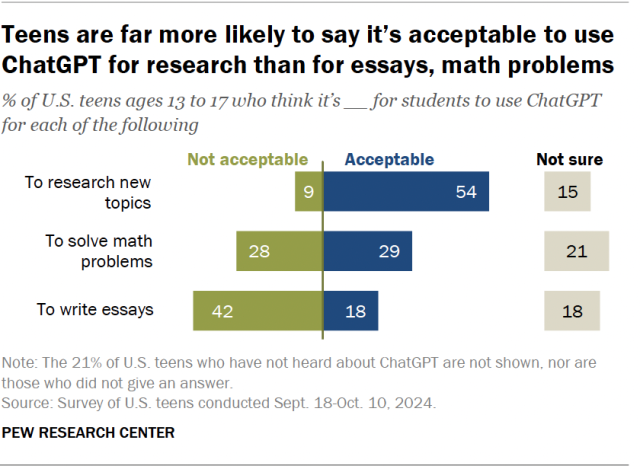
Just over half of teens say it’s acceptable to use ChatGPT to research new topics (54%). Only 9% say it is not acceptable to use it for this.
Far fewer support using the chatbot to do math or write essays:
- 29% of teens say it’s acceptable to use ChatGPT to solve math problems, while 28% say it’s not acceptable.
- 18% say it’s acceptable to use ChatGPT to write essays, and 42% say it’s not acceptable.
Another 15% to 21% of teens are unsure whether it’s acceptable to use ChatGPT for these tasks.
How familiar are teens with ChatGPT?
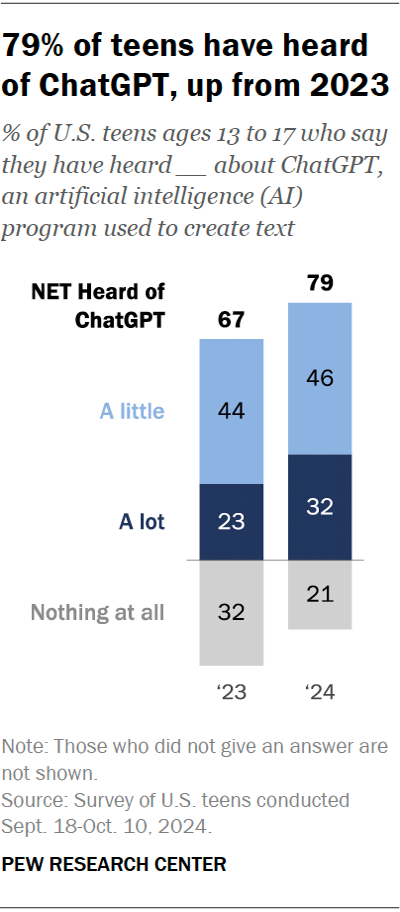
Teens’ awareness of ChatGPT has grown. Overall, 79% of teens say they have heard of this chatbot, up from 67% in 2023.
They have also become more familiar with ChatGPT. The share who say they have heard a lot about it has risen from 23% in 2023 to 32% today.
Teens who are most familiar with ChatGPT are more likely to use it for their schoolwork. Some 56% of teens who say they’ve heard a lot about it report using it for schoolwork. This share drops to 18% among those who’ve only heard a little about it.
Teens who are most familiar with the chatbot are also more likely to say using it for schoolwork is OK. For instance, 79% of those who have heard a lot about ChatGPT say it’s acceptable to use for researching new topics. This compares with 61% of those who have heard only a little about it.
While most teens have heard about ChatGPT, awareness varies across groups:
By race and ethnicity
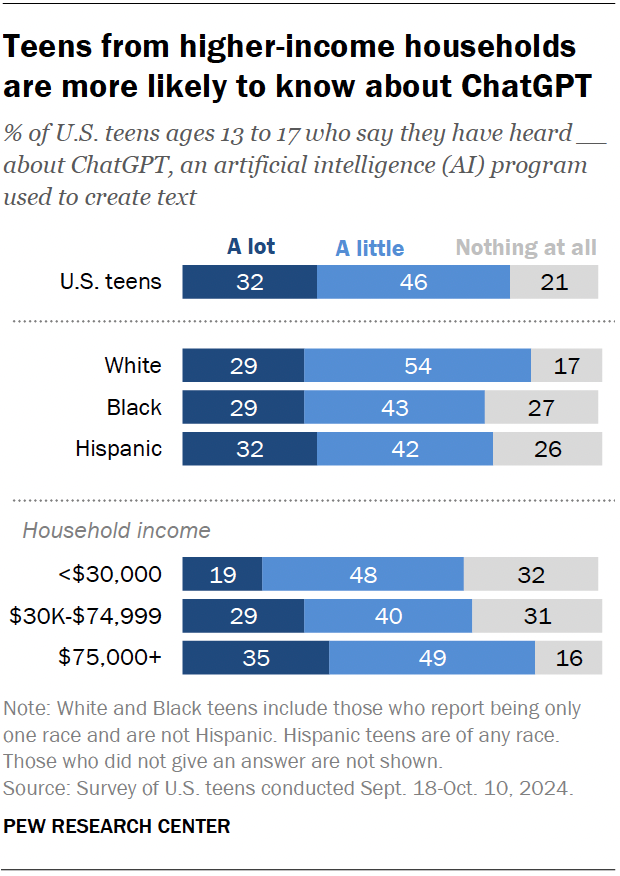
White teens (83%) are more likely than Black (73%) and Hispanic teens (74%) to say they’ve heard a lot or a little about ChatGPT.
By household income
Teens from households with higher annual incomes are most likely to say they’ve heard about ChatGPT. The shares who say this include:
- 84% of teens in households with incomes of $75,000 or more say they’ve heard at least a little about ChatGPT.
- 69% of those in households with incomes between $30,000 and $75,000 say they’ve heard of it.
- 67% of those in households with incomes below $30,000 say the same.
That said, teens in the lowest-income households grew the most in their awareness of ChatGPT over the past year. While 41% said they had heard of the chatbot in 2023, 67% say so now – an increase of 26 percentage points. By comparison, awareness of ChatGPT increased by 11 points among teens in households with incomes between $30,000 and $75,000 and 9 points among teens in households with incomes of $75,000 or more.
Note: Here are the questions used for this analysis, along with responses, and its methodology.


